
The French Navy, informally La Royale, is the maritime arm of the French Armed Forces and one of the four military service branches of France. It is among the largest and most powerful naval forces in the world recognised as being a blue-water navy. The French Navy is capable of operating globally and conducting expeditionary missions, maintaining a significant overseas presence. The French Navy is one of eight naval forces currently operating fixed-wing aircraft carriers, with its flagship Charles de Gaulle being the only nuclear-powered aircraft carrier outside the United States Navy, and one of two non-American vessels to use catapults to launch aircraft.
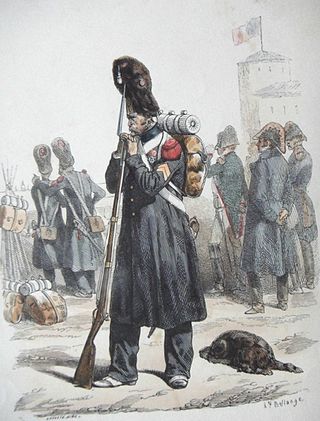
The Imperial Guard was originally a group of elite soldiers of the French Army under the direct command of Napoleon I, but grew considerably over time. It acted as his bodyguard and tactical reserve, and he was careful of its use in battle. The Guard was divided into the staff, infantry, cavalry, and artillery regiments, as well as battalions of sappers and marines. The guard itself as a whole distinguished between the experienced veterans and less experienced members by being separated into three sections: the Old Guard, Middle Guard and Young Guard. The Young Guard was virtually annihilated in the Battle of Krasnoi during the French invasion of Russia.

The rank insignia of the French Navy are worn on shoulder straps of shirts and white jackets, and on sleeves for navy jackets and mantels. Until 2005, only commissioned officers had an anchor on their insignia, but enlisted personnel are now receiving them as well. Although the names of the ranks for superior officers contain the word "Capitaine", the appropriate style to address them is "Commandant", "Capitaine" referring to "lieutenant de vaisseau", which is translated as lieutenant. The two highest ranks, Vice-amiral d'escadre and Amiral (Admiral), are functions, rather than ranks. They are assumed by officers ranking Vice-amiral (Vice-Admiral).
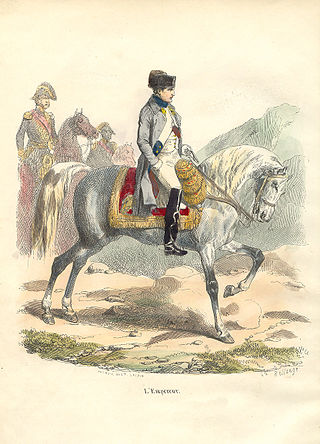
The uniforms of La Grande Armée, the army of Napoleon I, are described in this article.
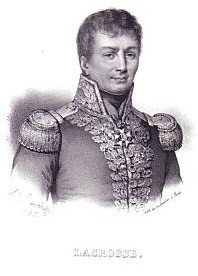
Jean-Baptiste Raymond de Lacrosse was a French sailor, admiral and hero of the French Revolutionary Wars.

The 2e régiment de chevau-légers lanciers de la Garde Impériale was a light cavalry regiment in Napoleon I's Imperial Guard. They were formed in 1810, after the Kingdom of Holland was annexed by France, but their original purpose was to serve as hussars of the Dutch Royal Guard. The units, who were of an elite order, were known for their loyalty and military might, as well as their professionalism in and out of battle.
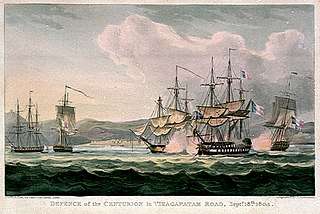
The Sémillante was a 32-gun frigate of the French Navy and the lead ship of her class. She was involved in a number of multi-vessel actions against the Royal Navy, particularly in the Indian Ocean. She captured a number of East Indiamen before she became so damaged that the French disarmed her and turned her into a merchant vessel. The British captured her and broke her up in 1809.

Admiral Pierre-Louis-Charles Rigault de Genouilly was a French naval officer. He fought with distinction in the Crimean War and the Second Opium War, but is chiefly remembered today for his command of French and Spanish forces during the opening phase of the Cochinchina campaign (1858–62), which inaugurated the French conquest of Vietnam.

The action of 14 December 1798 was a naval skirmish between the 32-gun British frigate HMS Ambuscade and the French 24-gun corvette Bayonnaise. Bayonnaise was vastly outgunned and outmanoeuvred, but was able to board and capture Ambuscade.
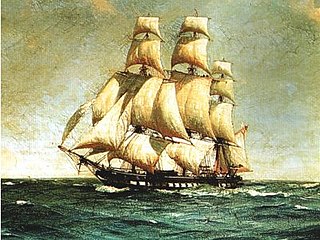
Sensible was a 32-gun Magicienne-class frigate of the French Navy. The Royal Navy captured her in 1798 off Malta and took into service as HMS Sensible. She was lost in a grounding off Ceylon in 1802.

The Battle of Alcolea Bridge was a minor battle that took place on 7 June 1808, during the Peninsular War, at Alcolea, a small village 10 km from Córdoba, the city that would be invaded by French troops later that same afternoon.

Dominique Honoré Antoine Vedel was a French general who participated in the French Revolution, the War of the Fourth Coalition and the Peninsular War.
François Henri Eugène Daugier was a French naval officer and politician.
The French brig Pandour was a brig of the French Navy launched in 1804 that the Royal Navy captured in 1806. In 1807 she became a whaler in the South Seas Fisheries, but was lost in late 1809.
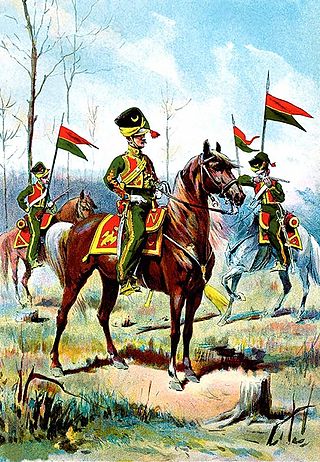
The Lithuanian Tatars of the Imperial Guard were a light cavalry squadron of Napoleon's Imperial Guard, in the service of the French Army from 1812 to 1814. The Lithuanian Tatars, descendants of Crimean Tatars, were organized into a single squadron at the beginning of the Russian Campaign. Their first commander was Squadron Leader Achmatowicz, who was killed at Vilnius and succeeded by Captain Ulan, who led the unit through the remainder of the war. Following the First Abdication of Napoleon, all foreign units were disbanded, and the regiment followed.

Inconstant was a Sylphe-class brig, one of 32, launched in 1811 for the French Navy. In 1815, Napoleon used her to escape from exile on Elba. In the 1820s she took part in the war with Spain and later served on the Brazil station. She also served on the French Guiana station. She was broken up at Brest in December 1843.
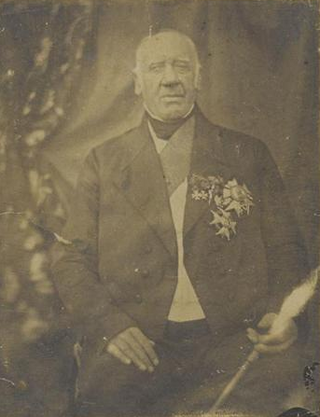
Baron Henri Rottembourg became a French division commander late in the Napoleonic Wars. He enlisted in an infantry regiment of the French Royal Army in 1784 and was promoted to first lieutenant by 1792. During the War of the First Coalition from 1793 to 1797 he fought mostly in the Army of Sambre-et-Meuse. He was wounded at Verona in 1799 and fought on the Var and at the Mincio in 1800. He transferred to the Imperial Guard in 1806 before fighting at Jena and being named to command an infantry regiment. In 1809 he was wounded at Wagram.
Jean François Louis de Brach was a French naval officer who was governor of Martinique from 1728 to 1739.

The FrenchImperial Naval Corps was the branch of the French Imperial Navy responsible for administering the infantry and artillery which was tasked with manning and utilising the weapons on the Navy's ships. The corps comprised two 'official' branches and Naval Artillery and one 'unofficial branch'. The Naval Infantry and Naval Artillery formed the 'official' branches as they were under the direct control of the navy and Naval corps. However, the Coastal Artillery was de facto an 'unofficial' branch, as it remained under control of the army for operational duties, while administration and supply was given to the Navy.
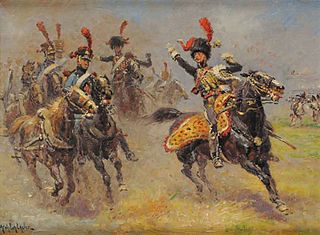
The Imperial Guard Artillery was made up of the organic units of the Imperial Guard of Napoleon I's's. It comprised a regiment of horse artillery, regiments of foot artillery and a train service responsible for supplying guns with powder and ammunition.


















